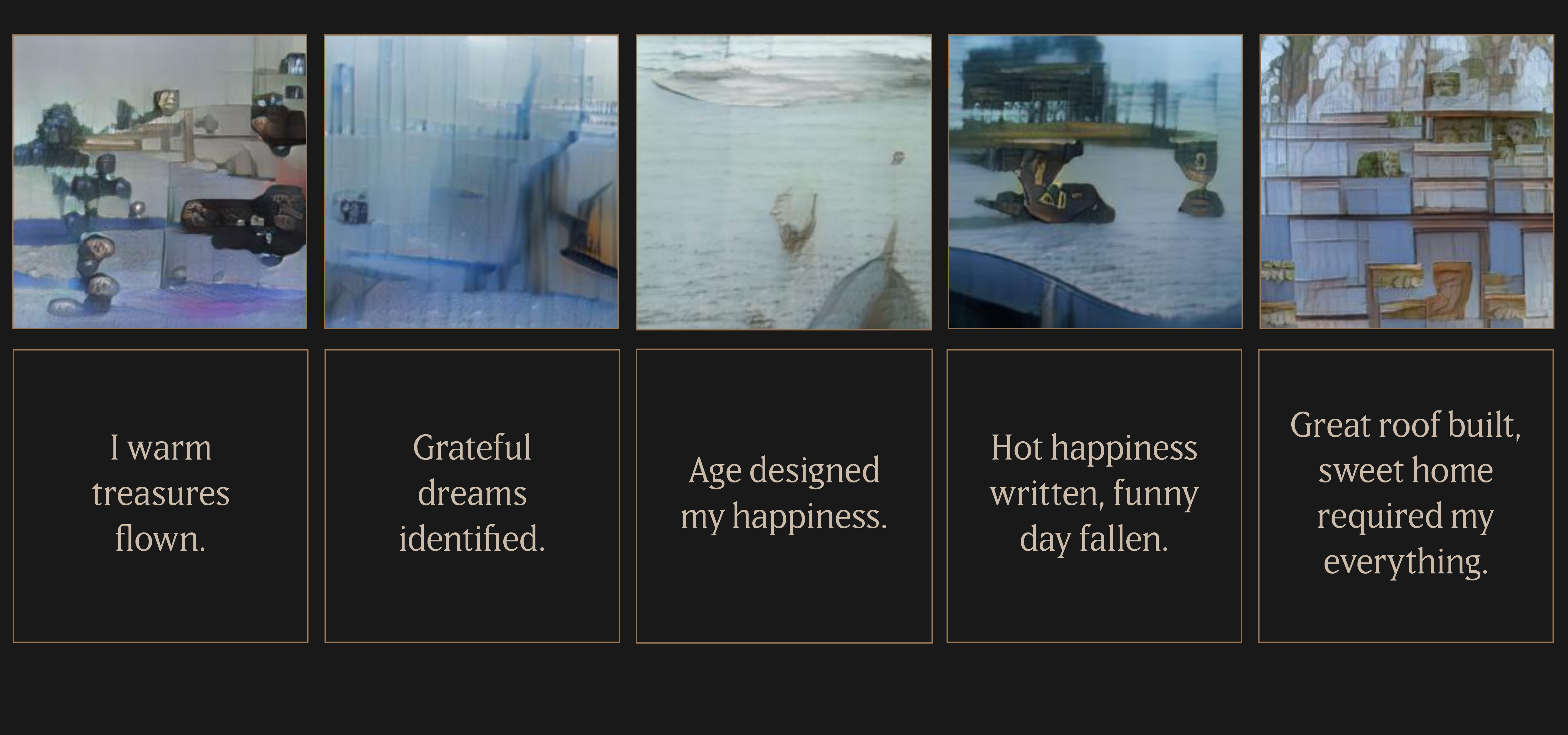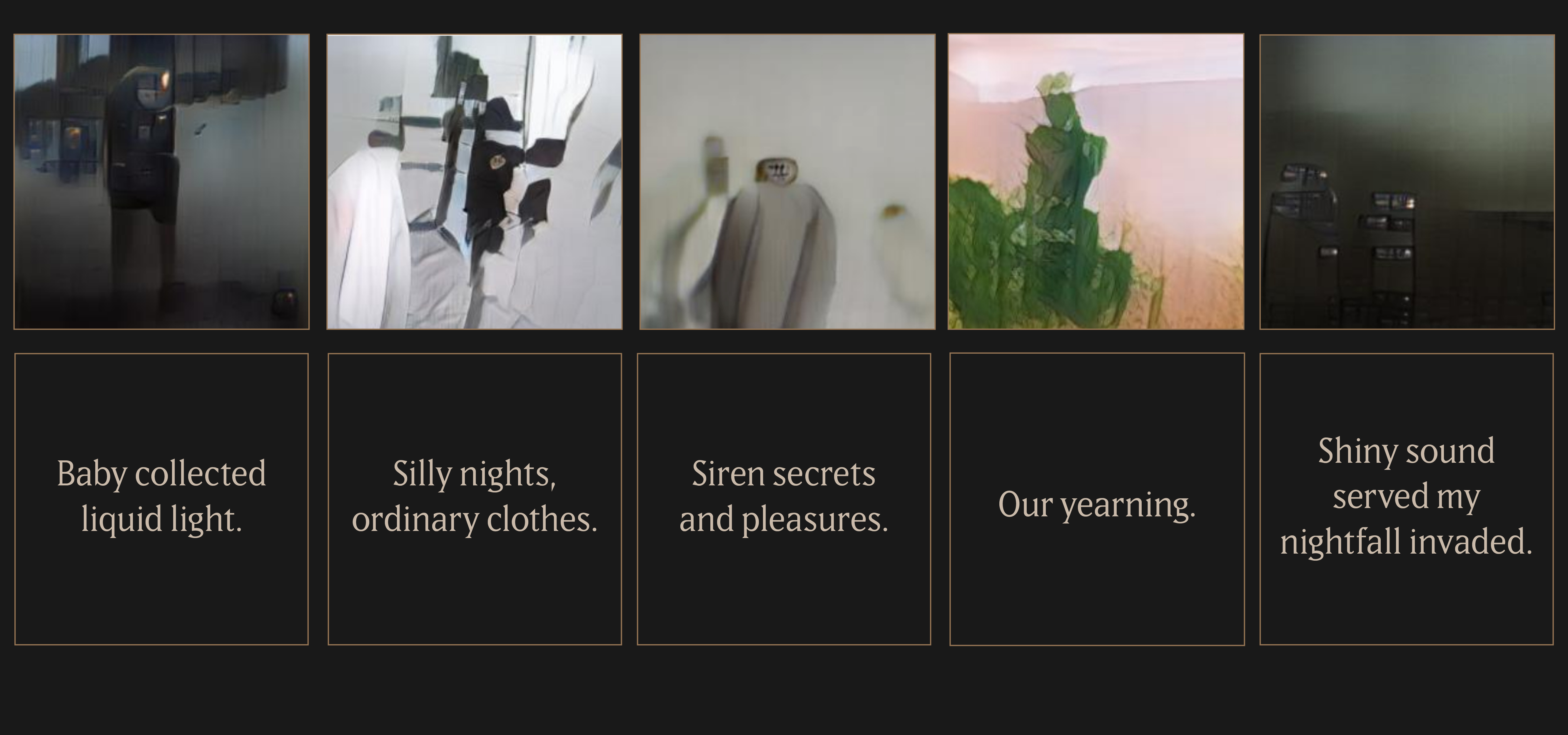Poetics of Digitally Augmented Space
Poetics of Digitally Augmented Space
Poetics of Digitally Augmented Space
Poetics of Digitally Augmented Space
Computation, Machine Learning, Experimental Publishing.
A commisioned corpus of poetry to use in Natual Language Processing with Python, a programming language typically used in machine learning.
Images were created by running the algorithmicaly generated texts through an Generative Advisarial Network (GAN).
Computation, Machine Learning, Experimental Publishing.
A commisioned corpus of poetry to use in Natual Language Processing with Python, a programming language typically used in machine learning.
Images were created by running the algorithmicaly generated texts through an Generative Advisarial Network (GAN).
Computation, Machine Learning, Experimental Publishing.
A commisioned corpus of poetry to use in Natual Language Processing with Python, a programming language typically used in machine learning.
Images were created by running the algorithmicaly generated texts through an Generative Advisarial Network (GAN).
Screens have made their way into our physical intimate spaces. More interestingly though, the digital has given way to new invented intimate spaces we can inhabit online. I think what is important about this in relationship to graphic design is that it opens up a new way of thinking about design. Design could be the design of a corpus or dataset to feed an algorithm, or the design of the algorithm itself. Both generate visual culture. The following image sets show short generated texts and the result of a machine learning algorithm tasked with making representational images from those texts.
I think of these as ephemeral paintings and poetic language. I think they are also useful to demo the hidden labor of machine learning and it's potential for biased design or authorship.

For the last year I’ve been working after Bachelard's text, The Poetics of Space, to hypothesize about the resulting changes our intimate space underwent when digital technologies became integrated into our homes. We have brought the network into our rooms, the internet of things becoming prosthetics of space. We allow them to alter our vision of the world and each other.
I’ve been thinking about this project as a way to change the inputs of our digital culture “algorithms” in an attempt to think about localizing or being able to find a way to get more transparency and autonomy back from algorithmic culture. Generative, predictive text is being served to you across all your devices but we don't know from where it comes from or whose labor is being exploited.
I began by commissioning Amazon Turk workers to write poetically about certain areas of their homes that Bachelard elaborates upon. This task led to the accumulation of 500 unique pieces of writing. I haven’t read them—instead I’ve used the texts as input for computational programs of my own design. In each experiment, I hope to come closer to revealing something about how we view our spaces 60 years after Bachelard's initial publishing, when homes are both node and oasis—hyper-connected, surveilled—yet still our own, with our own unique ip address.
For the last year I’ve been working after Bachelard's text, The Poetics of Space, to hypothesize about the resulting changes our intimate space underwent when digital technologies became integrated into our homes. We have brought the network into our rooms, the internet of things becoming prosthetics of space. We allow them to alter our vision of the world and each other.
I’ve been thinking about this project as a way to change the inputs of our digital culture “algorithms” in an attempt to think about localizing or being able to find a way to get more transparency and autonomy back from algorithmic culture. Generative, predictive text is being served to you across all your devices but we don't know from where it comes from or whose labor is being exploited.
I began by commissioning Amazon Turk workers to write poetically about certain areas of their homes that Bachelard elaborates upon. This task led to the accumulation of 500 unique pieces of writing. I haven’t read them—instead I’ve used the texts as input for computational programs of my own design. In each experiment, I hope to come closer to revealing something about how we view our spaces 60 years after Bachelard's initial publishing, when homes are both node and oasis—hyper-connected, surveilled—yet still our own, with our own unique ip address.

Softwares Used:
AttnGAN: Fine-Grained Text to Image Generation with Attentional Generative Adversarial Networks was engineered by Tao Xu, Pengchuan Zhang, Qiuyuan Huang, Han Zhang, Zhe Gan, Xiaolei Huang, and Xiaodong He.
Amazon Turk workers have a unique perspective upon this area as they're the hidden labor accumulates the data sets that engineers use to train the machine. Their homes, though worldwide, have a similar condition, digital connectivity. A corpus is what we use as a data set in natural language processing and machine learning. Changing the corpus will change the results of your algorithms.
The authorship of the short texts lies between the python libraries, myself, and the corpus of 500 writings. The authorship of the images lies between the text and the image generating model asked to draw what the text describes. This algorithm was trained on coco, an object detection and captioning dataset. The text creates surreal images that resist representation.
